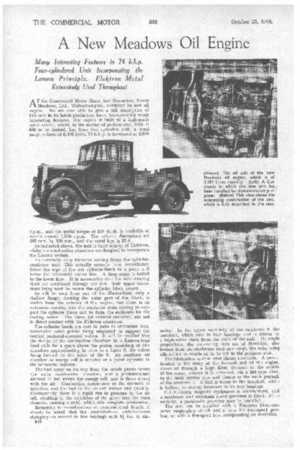A 'Jew Meadows Oil Engine
Page 44

If you've noticed an error in this article please click here to report it so we can fix it.
Many Interesting Features in 74 b.h.p. Four-cylindered Unit Incorporating the Lanova Principle. Elektron Metal Extensively Used Throughout
AT the Commercial Motor Show, last November, Henry Meadows, Ltd., Wolverhampton, exhibited its new oil engine. We are now able to give a full description of this unit in its latest production form. Incorporating many interesting features, this engine is built to a high-grade specification, whilst, in the matter of performance, little is -left to be desired, for, from four cylinders with a total swept volume of 5.195 litres, 74.h.h.p. is developed at 2,000
r.p.m., and the useful torque of 218 lb.-ft. is available at speeds around 1,500 r.p.m. The cylinder dimensions are 105 mm. by 150 mm., and the rated h.p. is 27.4. As indicated above, the unit is built largely of Elektron, whilst the combustion chambers are designed to incorporate the Lanova system.
An extremely deep Elektron. casting forms the cylindercrankcase unit. This actually extends from immediately below the tops of the wet cylinder-liners to a point well below the crankshaft centre line. A deep sump is bolted to the lower face, It is noteworthy that the main-bearing studs are continued through the case, their upper extensions being used to secure the cylinder block proper.
As will be seen from one of the illustrations, only a shallow flange, forming the outer part of the block, is visible from the exterior of the engine, but there is an extension running into the crankcase main casting to support the cylinder liners and to form the enclosure for the cooling water. The liners (of nitrided cast-iron) are not in direct contact with the Elektron crankcase.
The cylinder heads are cast in pairs in chromium iron, detachable valve guides being employed to support the vertical push-rod-operated valves. It will be recalled that the design of the combustion chambers in a Lanova-type head calls for a space above the piston consisting of two chambers approximating in form to a figure 8, the valves being located in the lobes of the 8. An auxiliary air chamber or energy cell is situated at a point opposite to the horizontal injector.
The fuel spray on its way from the nozzle passes across the main combustion chamber, and a predetermined amount of fuel enters the energy cell, and is there mixed with the air. Combustion commences at the moment of injection, and the fuel in the air cell follows suit quickly. Consequently there is a rapid rise in pressure in the air cell, resulting in the expulsion of the gases into the main chamber, causing a swirl, which aids complete combustion.
Returning to considerations of constructional details, it should be noted that the crankshaft—a nickel-chrome stamping—is carried in five bearings each 31ins. in dia
810
meter, In the upper extremity of the crankcase is the camshaft, which runs in four bearings and is driven by a triple-roller chain from the front of the unit. Of ,ample proportions, the connecting rods are of H-section, also formed from nickel-chrome steel stampings, the webs being rifle-drilled to enable oil to be led to the gudgeon pins.
The lubrication system next claims attention. A pump, located in the sump at the forward end of the engine, draws oil through a large filter, situated in the middle of the sump, whence it is delivered, via a felt-type filter, to the main service pipe and thence to the main journals of the crankshaft. A lead is taken to the camshaft, which is hollow, to convey lubricant to its four bearings. C.A.V.-Bosch magneto equipment is standardized, and a maximum and minimum speed governor is fitted. Alternatively, a pneumatic governor may be installed. The unit can be supplied with a Meadows 14-in.-diameter single-plate clutch and a type 9D four-speed gearbox, or with a five-speed box incorporating an overdrive.




























































































